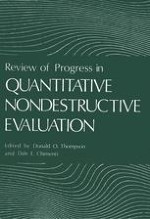In this volume (parts 1 and 2) are contained the edited papers presented at the annual Review of Progress in Quantitative NDE held at the University of California, San Diego, August 1-6, 1982. This Review, possibly the most comprehensive annual symposium emphasizing both ongoing research and applications in quantitative NDE, was sponsored by the Center for Advanced NDE at the Ames Laboratory of the U. S. Department of Energy in cooperation with the Materials Laboratory of the Air Force Wright Aeronautical Laboratories and the Defense Advanced Research Projects Agency. Over 300 attendees representing various government agencies and the industrial and university communities participated in the technical presentations, poster sessions, and discussions. The symposium benefited from the insight of two keynote speak ers, Dr. Harris Burte of the Materials Laboratory, AFWAL, and Mr. Ward Rummel of the Martin Marietta Corporation, who presented complementary messages. Dr. Burte pointed out the need to identify "windows" to serve as guides for focusing NDE research. The "window" concept may be thought of as an opportunity for the application of NDE technology to an important problem and, through this application, to identify knowledge gaps which must be filled by generic research. This concept simultaneously provides a mechanism for the solution of a direct ap plication problem and a set of strong guidelines for generic research directions. Mr. Rummel called attention to the value of "lessons learned" from var.
